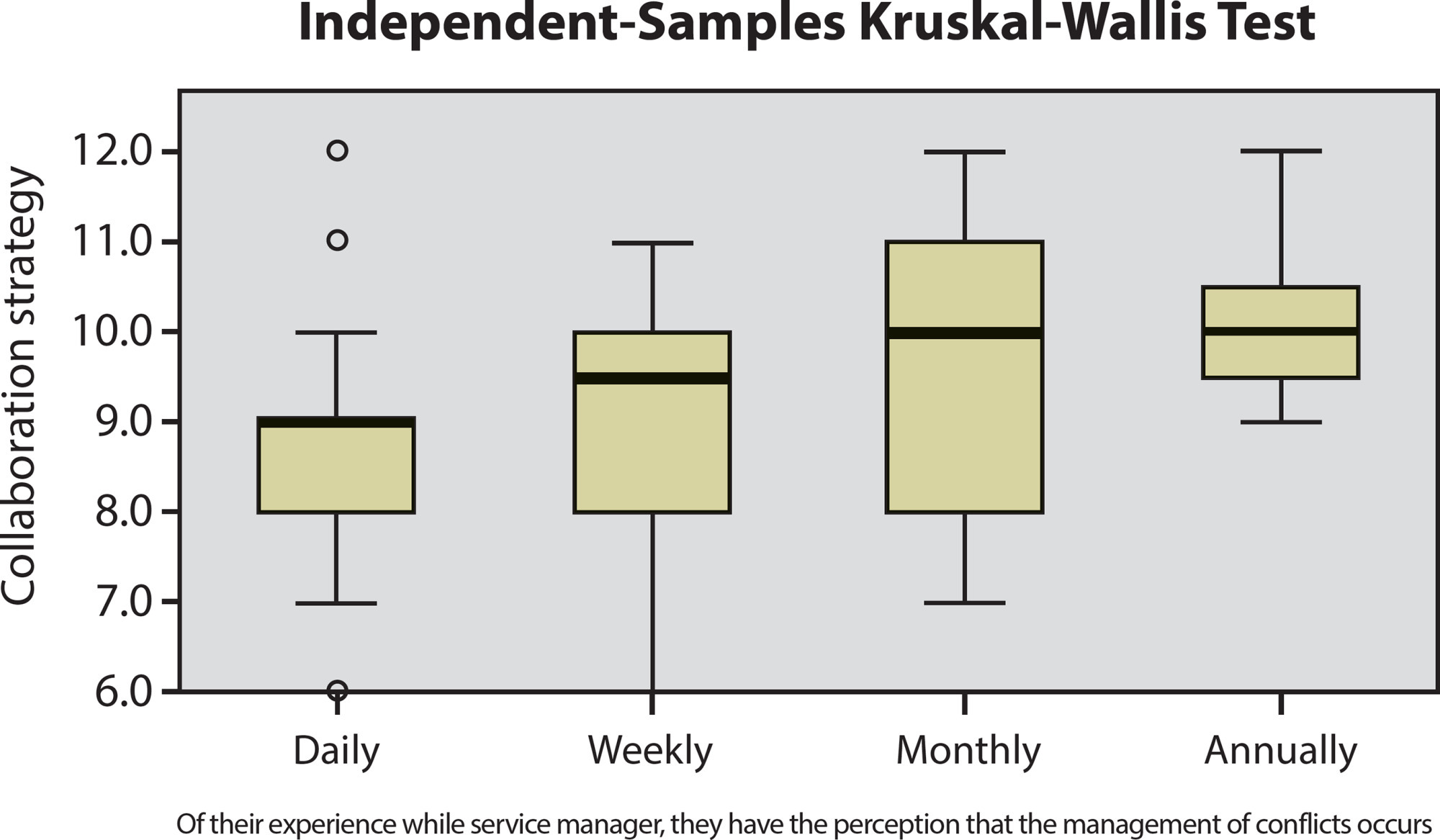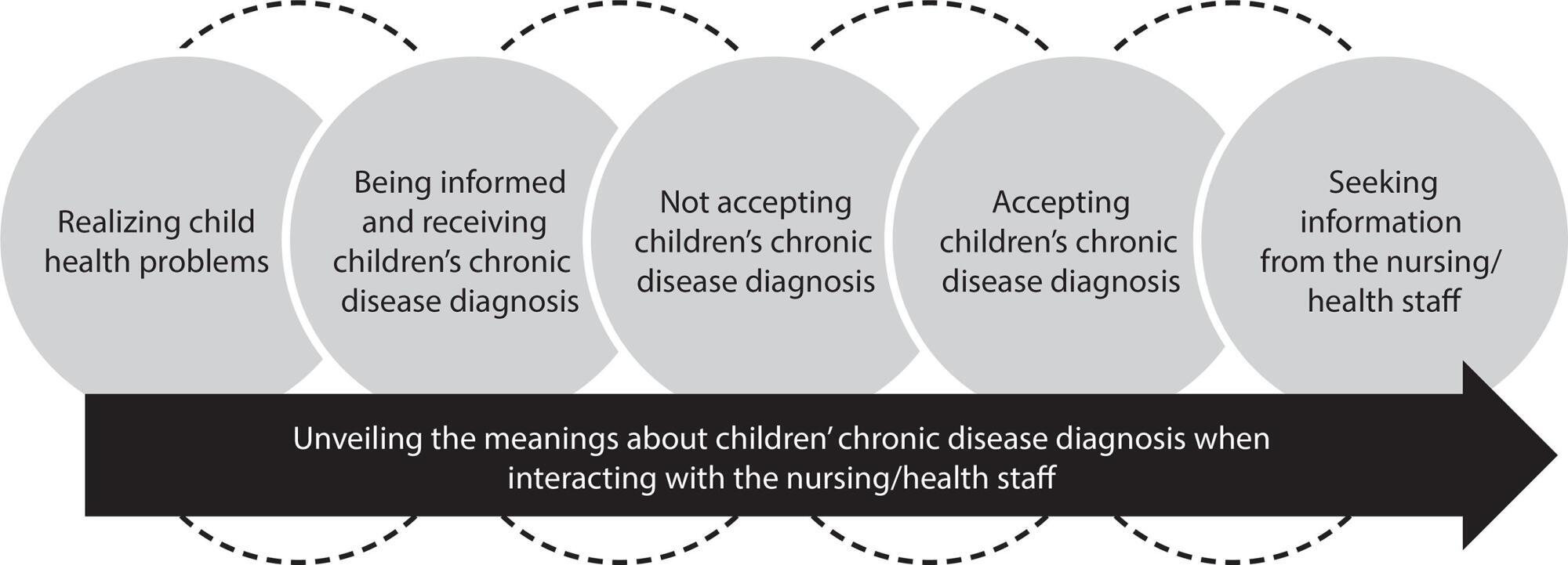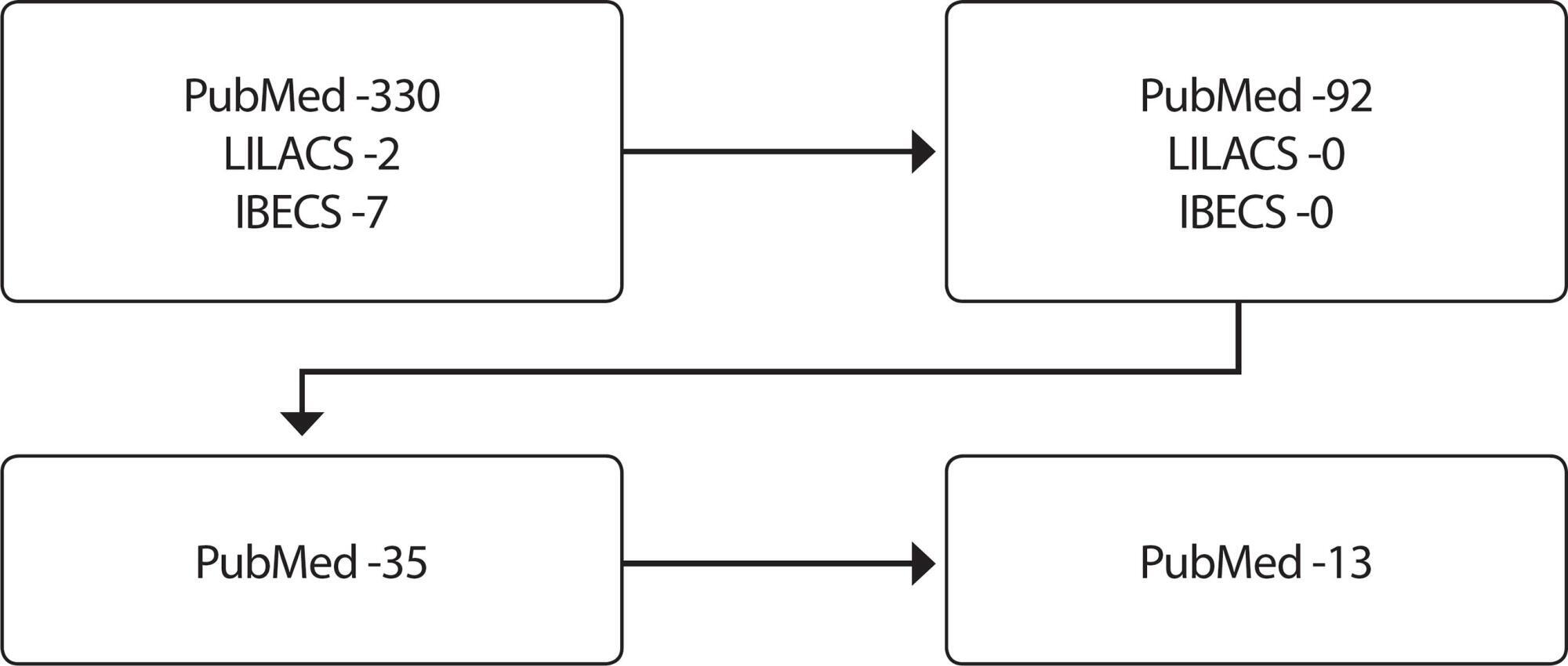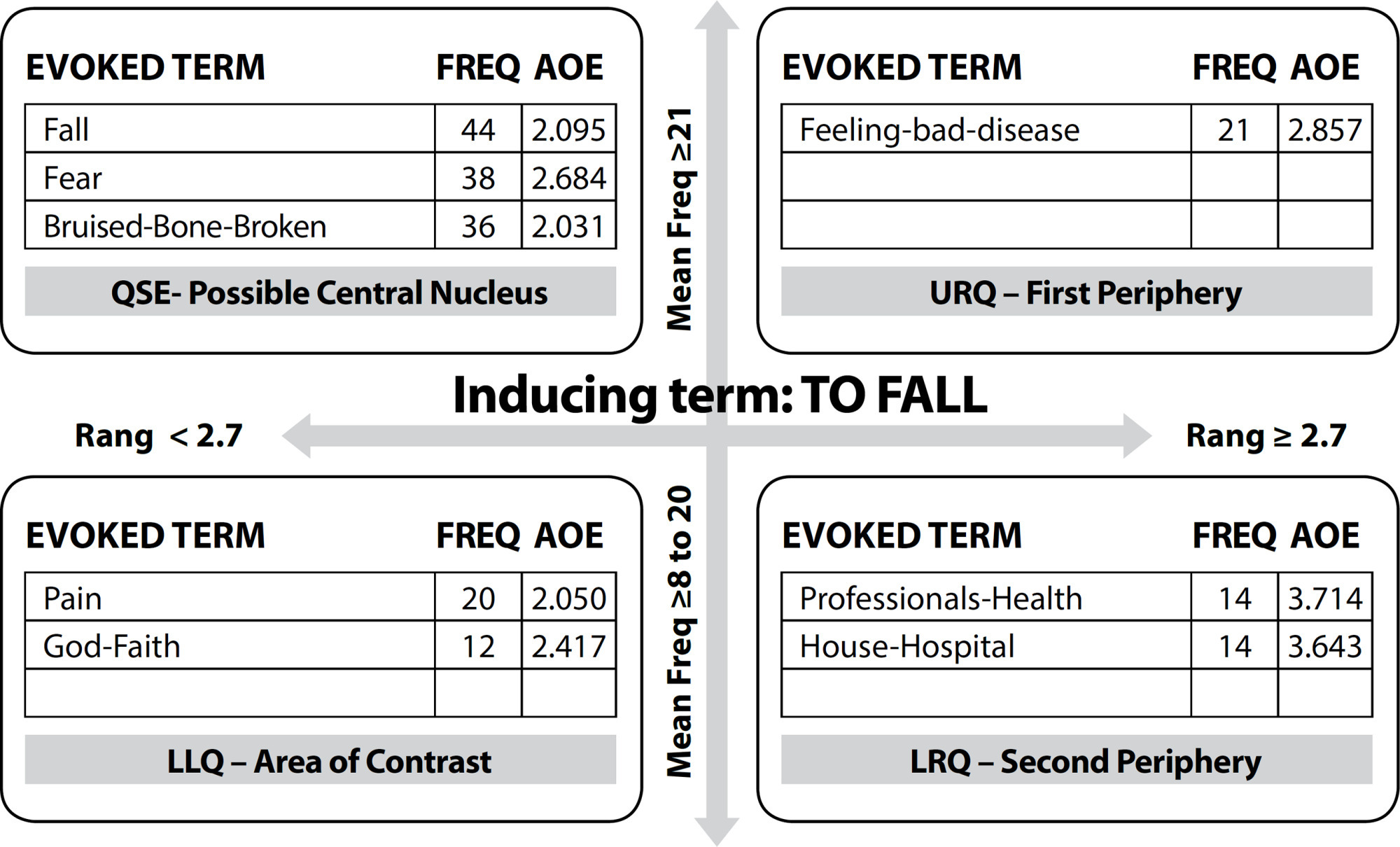-
RESEARCH01-01-2018
Professional exhaustion, quality and intentions among family health nurses
Revista Brasileira de Enfermagem. 2018;71:2295-2301
Abstract
RESEARCHProfessional exhaustion, quality and intentions among family health nurses
Revista Brasileira de Enfermagem. 2018;71:2295-2301
DOI 10.1590/0034-7167-2016-0510
Views0See moreABSTRACT
Objective:
to analyze how family health nurses assess quality of care; check if they have any intention of leaving their current job and nursing; estimate prevalence of professional exhaustion; and correlate these variables.
Method:
cross-sectional and correlational study with 198 nurses. The Maslach Burnout Inventory was applied, as it has questions for characterizing nurses, assessing perception on quality of care and of material and human resources, and verifying intention of leaving current work and nursing.
Results:
most nurses assess quality of care as good, 28.0% present emotional exhaustion, there is intention of leaving current work and nursing.
Conclusions:
family health nurses experience professional exhaustion, which in turn presents correlation with decreased quality of care and increased intentions of leaving current work and nursing.
-
RESEARCH01-01-2018
Ombudsman’s experience in Psychosocial Care Centers for alcohol/drugs
Revista Brasileira de Enfermagem. 2018;71:2287-2294
Abstract
RESEARCHOmbudsman’s experience in Psychosocial Care Centers for alcohol/drugs
Revista Brasileira de Enfermagem. 2018;71:2287-2294
DOI 10.1590/0034-7167-2017-0924
Views0See moreABSTRACT
Objective:
The objective of the study was to analyze criticisms, compliments and suggestions of users, family and workers, placed in an Ombudsman of a Centro de Atenção Psicossocial para Álcool e outras Drogas (Psychosocial Care Centers for Alcohol and Other Drugs- CAPS ad).
Method:
A study carried out in the CAPS ad of Macapá-AP from August to December 2016, through the thematic content analysis of the files deposited in the ombudsman, recently introduced in the service, containing criticisms, compliments and suggestions from users, family members, and CAPS ad.
Results:
It was observed the dissatisfaction with the infrastructure of the CAPS ad, and with the relationships built between users and professionals, in addition, suggestions were given of workshops, and improvement in the development of the Projeto Terapêutico Singular (freely translated as Unique Therapeutic Project).
Final considerations:
It is concluded that the multidisciplinary team needs to put in practice the real psychosocial care in the service, and that the management helps in the improvement of the service’s place, and in the proposal of qualifications to this team.
-
RESEARCH01-01-2018
Nursing students’ sense perception of communication in psychiatric hospital
Revista Brasileira de Enfermagem. 2018;71:2280-2286
Abstract
RESEARCHNursing students’ sense perception of communication in psychiatric hospital
Revista Brasileira de Enfermagem. 2018;71:2280-2286
DOI 10.1590/0034-7167-2017-0957
Views0See moreABSTRACT
Objective:
to analyze the sense perception of nursing students in the learning of communication in a psychiatric hospital.
Method:
qualitative, exploratory and descriptive, from representative drawings of the communication perceived by the body senses of 23 nursing students, and recorded enunciation of the remarkable experiences after the end of the practical activities. The data were analyzed according to thematic content.
Results:
the heart captures perceptions, favoring interpersonal relationships; smelling shows care lacking in hospitalization; vision monopolizes the impressions of reality, making the movements static; hearing is exercised in the amplitude to listen; touching demarcates limitations of contact and interaction; and tasting, as social sense, seeks to overcome the obstacles to take care.
Conclusion:
the learning of communication was significant, making the psychiatric hospital a space to listen to what is inside, to find in the emotions and rationalities the sensations that can be inside and outside the tension nodes that interfere in the perceptions.
-
RESEARCH01-01-2018
Feelings of families regarding drug dependence: in the light of comprehensive sociology
Revista Brasileira de Enfermagem. 2018;71:2272-2279
Abstract
RESEARCHFeelings of families regarding drug dependence: in the light of comprehensive sociology
Revista Brasileira de Enfermagem. 2018;71:2272-2279
DOI 10.1590/0034-7167-2018-0150
Views0See moreABSTRACT
Objective:
to understand the feelings of families before drug dependence.
Method:
exploratory, analytical and qualitative study carried out with families of drug users, which are followed up by the Centro de Atenção Psicossocial Álcool e Drogas (Psychosocial Care Center for Alcohol and DARUGS). The collection of data took place by in-depth interview, with the support of field diary. Three visits were done, on average, for each family. The software IRAMUTEQ was adopted for textual corpus organization and was discussed in the light of Michel Maffesoli.
Results:
nine families participated in the research; from the analysis, four classes arose: “My life has changed a lot because of drugs”; “I fear leaving him alone”; “I trust and have faith in God”, and “I am always worried in my own house”.
Final considerations:
the families revealed how much drug dependence did not only affect the user, but also the whole family, provoking in the family complex feelings and emotions.

-
RESEARCH01-01-2018
Project K: Training for hospital-community safe transition
Revista Brasileira de Enfermagem. 2018;71:2264-2271
Abstract
RESEARCHProject K: Training for hospital-community safe transition
Revista Brasileira de Enfermagem. 2018;71:2264-2271
DOI 10.1590/0034-7167-2018-0190
Views0See moreABSTRACT
Objective:
To define the safe transition process from hospital to community of patients with chronic mental disorders and their families.
Method:
This was an action research study included in the constructivist paradigm. The participants in the study were nurses from a psychiatry service and from primary healthcare services.
Results:
After the identification of causes of continuity fragmentation, the following items emerged from the participants’ speeches: a) two criteria categories for safe transition (those associated with health status, dependence level, and self-care capacity of patients, and those associated with knowledge and competence level of informal caregivers); b) the design of an algorithm to facilitate clinical decision-making.
Final considerations:
In order to promote adherence to therapeutic treatment in the hospital-community transition, treatment plans must include patients and their families, and improve communication networks and support among care levels.

-
RESEARCH01-01-2018
Screening and Brief Intervention for the use of alcohol and other drugs
Revista Brasileira de Enfermagem. 2018;71:2258-2263
Abstract
RESEARCHScreening and Brief Intervention for the use of alcohol and other drugs
Revista Brasileira de Enfermagem. 2018;71:2258-2263
DOI 10.1590/0034-7167-2017-0444
Views0See moreABSTRACT
Objective:
to identify the lifetime use of alcohol and other drugs among users of the Family Health Strategy and apply Brief Intervention to problems related to the use of these substances.
Method:
a descriptive cross-sectional study where 1,031 users of the Family Health Strategy of the city of Rio de Janeiro answered a form with socio-demographic information and the Alcohol, Smoking and Substance Involvement Screening Test. Statistical analysis with simple frequency distribution was performed.
Results:
the most commonly used drugs in lifetime were alcohol and tobacco; among the illegal drugs, marijuana, hypnotics and cocaine/crack stood out. Those who received most Brief Intervention were users of tobacco, hypnotics, marijuana, cocaine/crack and alcohol.
Conclusion:
it is important to detect early problems associated with the use of alcohol and other drugs in Primary Care, since it has the promotion/protection of health and the prevention of diseases as priority health practices.
-
RESEARCH01-01-2018
Night beds in psychosocial attention care centers for alcohol and drugs: analysis and characterization
Revista Brasileira de Enfermagem. 2018;71:2251-2257
Abstract
RESEARCHNight beds in psychosocial attention care centers for alcohol and drugs: analysis and characterization
Revista Brasileira de Enfermagem. 2018;71:2251-2257
DOI 10.1590/0034-7167-2018-0149
Views1See moreABSTRACT
Objective:
To analyze and characterize the use of night beds in a Psychosocial Attention Care Center for Alcohol and Drugs (Centro de Atenção Psicossocial Álcool e Drogas – CAPS ad).
Method:
It is a quantitative, documental, descriptive and retrospective study. Data were gathered from 565 medical records. An analysis of continuous variables was performed.
Results:
When admitted to the beds, most users (87.6%) consumed multiple substances daily and were vulnerable, specially in street situation (68.3%). These users were admitted on an average of two times, undergoing a previous evaluation by the nurse (85.8%), usually for detoxication or due to the vulnerable condition. They stayed in the center for an average of seven days and 31.1% did not finish what was proposed. For a few cases, hospital support was needed. Overall, discharges were planned, but the return happened without booking.
Conclusion:
Social issues cut through the use of night beds, however, it is a therapeutic resource that meets significant demands and is present in the daily lives of vulnerable users as a comprehensive care.
-
RESEARCH01-01-2018
Adaptation and validation of the Measuring of Treatment Adherence for mental health
Revista Brasileira de Enfermagem. 2018;71:2243-2250
Abstract
RESEARCHAdaptation and validation of the Measuring of Treatment Adherence for mental health
Revista Brasileira de Enfermagem. 2018;71:2243-2250
DOI 10.1590/0034-7167-2017-0796
Views0See moreABSTRACT
Objective:
to adapt culturally and validate the Measuring Instrument of Treatment Adherence for mental health.
Method:
methodological study, carried out with 300 individuals with mental disorders, in two Psychosocial Care Centers in Curitiba, state of Paraná, Brazil, from April to June 2014. The cross-cultural adaptation was developed according to international recommendations, the construct validation was made by exploratory factor analysis, and internal consistency was verified by Cronbach’s alpha.
Results:
through the evaluation of a committee of experts and completion of the pre-testing, face and content validation was achieved. From the factor analysis, we identified two factors of the instrument’s construct: involuntary action and voluntary action, with a total explanation variance of 55.7%. The value of Bartlett’s test of sphericity was p<0.001. Cronbach’s alpha was 0.74.
Conclusion:
the adapted and validated instrument proved to be trustworthy to be applied to the verification of adherence to drug therapy for individuals with mental disorders.
-
ORIGINAL ARTICLE10-28-2020
Conflict management strategies used by Portuguese nurse managers
Revista Brasileira de Enfermagem. 2020;73:e20190336
Abstract
ORIGINAL ARTICLEConflict management strategies used by Portuguese nurse managers
Revista Brasileira de Enfermagem. 2020;73:e20190336
DOI 10.1590/0034-7167-2019-0336
Views0See moreABSTRACT
Objectives:
to analyze the perception and conflict management strategies used by nurses in the management of people in Portuguese health services.
Methods:
descriptive, correlational study, carried out in Portuguese health services, with an intentional non-probabilistic sample, totaling 95 nurse managers. A questionnaire and Conflict Management Scale were used, analyzing the variables of managerial activities and conflict management, with the aid of software.
Results:
it was identified that 60% of the managers, report having to mediate conflicts daily, and the majority report adopting dialogue in conduct. However, through the Kruskal-Wallis test, it was shown that enforcement strategies in conflict management prevail (p = 0.008), with collaborative ones being more restricted to monthly intervals (p = 0.049).
Conclusions:
managers perceive the importance of collaboration in the mediation of conflicts, however, in their daily lives; they tend to maintain imposing behaviors, signaling for a little transformational leadership style.

-
ORIGINAL ARTICLE10-01-2022
Frailty in the elderly: screening possibilities in Primary Health Care
Revista Brasileira de Enfermagem. 2022;75(2):e20200973
Abstract
ORIGINAL ARTICLEFrailty in the elderly: screening possibilities in Primary Health Care
Revista Brasileira de Enfermagem. 2022;75(2):e20200973
DOI 10.1590/0034-7167-2020-0973
Views0See moreABSTRACT
Objectives:
to evaluate two instruments for screening frailty in the elderly in Primary Health Care.
Methods:
this is an observational, cross-sectional study, with a quantitative approach, with 396 elderly people. SPSS software helped to perform the statistical analyses. The study used the kappa coefficient and Spearman’s correlation.
Results:
the kappa coefficient between the Clinical-Functional Vulnerability Index 20 and the Edmonton Frailty Scale was 0.496, considered moderate. There was a positive and significant correlation (r = 0.77; p < 0.001) between the frailty conditions and the total score of the two instruments.
Conclusions:
when this article assessed fragility through the kappa coefficient, both instruments presented positive correlation and agreement. However, the identification of frailty was higher when it used the Edmonton Frailty Scale.
-
ORIGINAL ARTICLE09-16-2019
Knowledge of nursing student on the prevention of sexually transmitted infections
Revista Brasileira de Enfermagem. 2019;72(5):1145-1152
Abstract
ORIGINAL ARTICLEKnowledge of nursing student on the prevention of sexually transmitted infections
Revista Brasileira de Enfermagem. 2019;72(5):1145-1152
DOI 10.1590/0034-7167-2017-0801
Views0See moreABSTRACT
Objective:
To identify the knowledge and self-care actions taken by nursing undergraduate students of a Federal University of the South of Brazil, against Sexually Transmitted Infections.
Method:
Exploratory qualitative study, conducted 40 interviews with undergraduate students at the beginning and end of the course. The analysis was thematic, resulting in three categories.
Results:
Knowledge about the subject is a decisive factor for self-care, and the more knowledge, the greater the prevention. The dissemination of knowledge of students at the end of the course not only influences self-care but also health promotion in the social sphere.
Final considerations:
Knowledge is important in self-care and caring for others. The dissemination of knowledge becomes evident according to the complexity of the course. Stable relationships may interfere with the use or disuse of condoms in sexual relationships, a misnomer present in today’s society.
-
ORIGINAL ARTICLE03-30-2020
Meanings assigned by families about children’s chronic disease diagnosis
Revista Brasileira de Enfermagem. 2020;73(2):e20180742
Abstract
ORIGINAL ARTICLEMeanings assigned by families about children’s chronic disease diagnosis
Revista Brasileira de Enfermagem. 2020;73(2):e20180742
DOI 10.1590/0034-7167-2018-0742
Views0See moreABSTRACT
Objectives:
to understand the meanings assigned by family caregivers about children’s chronic disease diagnosis.
Methods:
qualitative study, which used as theoretical framework the Symbolic Interactionism, and methodological, the Grounded Theory. It was held in a pediatric unit in Southern Brazil, in 2016, through interviews submitted to open and axial analysis, with the participation of 20 family caregivers of hospitalized children.
Results:
relatives, interacting with the nursing/health staff, perceive children’s disease at birth. They are diagnosed with chronic disease by the physician and deny it. Subsequently, they accept and seek information on care.
Conclusions:
the results pointed out the stages that relatives experience by assigning meanings to about children’s chronic disease diagnosis. These meanings provide subsidies for nurses’ actions, which need to be aware of children’s and family’s needs in order to offer comprehensive and humanized care.

-
03-09-2020
Psychiatric nursing and mental health teaching in relation to Brazilian curriculum
Revista Brasileira de Enfermagem. 2020;73(2):e20180200
Abstract
Psychiatric nursing and mental health teaching in relation to Brazilian curriculum
Revista Brasileira de Enfermagem. 2020;73(2):e20180200
DOI 10.1590/0034-7167-2018-0200
Views0See moreABSTRACT
Objectives:
to know the scientific production on psychiatric nursing and mental health teaching in relation to Brazilian nursing curriculum.
Methods:
an Integrative Literature Review with no temporal delineation, whose data collection took place in ten Brazilian and international databases, adding to the total 35 objects of analysis.
Results:
a priori categories were adopted, consisting of the psychiatric nursing and mental health teaching in Brazil according to the 1923, 1949, 1962, 1972, 1994 and 2001 nursing curriculum, presented in the light of the dimensions: thought model; places of practice; methods or contents used; and profile or skills of the student.
Final considerations:
the study made it possible to observe psychiatric nursing and mental health teaching historical evolution, indicating that teaching transformations involved changes in curriculum, Psychiatric Reform and the way nursing undergraduate courses and schools take these determinants.
-
08-19-2019
Professional education on dementias in Primary Health Care: an integrative review
Revista Brasileira de Enfermagem. 2019;72(4):1086-1093
Abstract
Professional education on dementias in Primary Health Care: an integrative review
Revista Brasileira de Enfermagem. 2019;72(4):1086-1093
DOI 10.1590/0034-7167-2018-0652
Views0See moreABSTRACT
Objective:
To investigate the most commonly used educational approaches in dementia training for primary health care professionals.
Method:
Integrative literature review, conducted between April and June of 2018, in PubMed, LILACS and IBECS databases. The descriptors used were: Training, Health Personnel, Dementia, Primary Health Care for PubMed; and the MeSH terms, Training Programs, Health Personnel, Dementia, and Primary Health Care for LILACS and IBECS.
Results:
The sample consisted of 13 articles; eight were published in the last five years (62%); seven articles with a quantitative approach (54%); seven articles produced on the European continent (54%), followed by five published on the North American continent (38%). All journals were from the health area (100%).
Conclusion:
Educational strategies were combined and used for education. Significant improvements in knowledge, skills, and attitudes of the teams with regard to professional management of dementias were evidenced.

-
05-21-2021
Quality of life and falls in elderly people: a mixed methods study
Revista Brasileira de Enfermagem. 2021;74:e20200400
Abstract
Quality of life and falls in elderly people: a mixed methods study
Revista Brasileira de Enfermagem. 2021;74:e20200400
DOI 10.1590/0034-7167-2020-0400
Views0See moreABSTRACT
Objective:
to assess elderly people’s quality of life, understanding the social representations of falls.
Methods:
a convergent mixed methods research carried out at homes, with a sample of 134 elderly people. A structured questionnaire was used, covering sociodemographic variables and factors that indicated frailty and risk of falling. For quality of life assessment, Medical Outcomes Study Short-Form 36 and Theory of Social Representations, Abric’s structural approach were used, with data treated by dictionary of equivalent terms, processed in Evoc 2000, converging analytically according to Neuman.
Results:
quality of life impairment was identified in terms of physical, emotional and functional capacity. The elements of the possible central nucleus were fall, fear, and bruised-broken-bone.
Final considerations:
quality of life impairment can contribute to increase the number of falls, which has been shown to be an event present in elderly people’s lives through evocations. Understanding elderly people’s individual demands allows planning actions.

-
ORIGINAL ARTICLE07-08-2020
Patient safety: perception of family members of hospitalized children
Revista Brasileira de Enfermagem. 2020;73(5):e20190525
Abstract
ORIGINAL ARTICLEPatient safety: perception of family members of hospitalized children
Revista Brasileira de Enfermagem. 2020;73(5):e20190525
DOI 10.1590/0034-7167-2019-0525
Views0See moreABSTRACT
Objectives:
to know the meaning attributed by family members to the health safety of pediatric patients, with attention to the possibilities of their collaboration.
Methods:
this qualitative study was conducted with eighteen family members of children hospitalized in a pediatric unit, from January to July 2018. Symbolic Interactionism was used as a theoretical framework, and Inductive Content Analysis as method.
Results:
child hospitalization poses risks to possible incidents and adverse events. Participants and professionals are responsible for patient safety. Thus, their actions focus on error prevention. Therefore, they seek information and observe in a vigil way professional care in classic aspects of safety. They conceive essential and favoring safety the approach centered on children and family members.
Final Considerations:
family members recognized the chances of errors and care damage, identified themselves as support in minimizing damage and were in partnership with the professional, increasing chances of effecting safety.
Search
Search in:
Nuvem de Tags
Adolescente (85) Atenção Primária à Saúde (239) COVID-19 (91) Criança (91) Cuidados de Enfermagem (269) Educação em Enfermagem (151) Educação em Saúde (139) Enfermagem (930) Enfermagem Pediátrica (86) Estudantes de Enfermagem (77) Estudos de Validação (131) Família (87) Idoso (208) Promoção da Saúde (99) Qualidade de Vida (104) Saúde do Trabalhador (86) Saúde Mental (145) Saúde Pública (82) Segurança do Paciente (150) Tecnologia Educacional (100)



